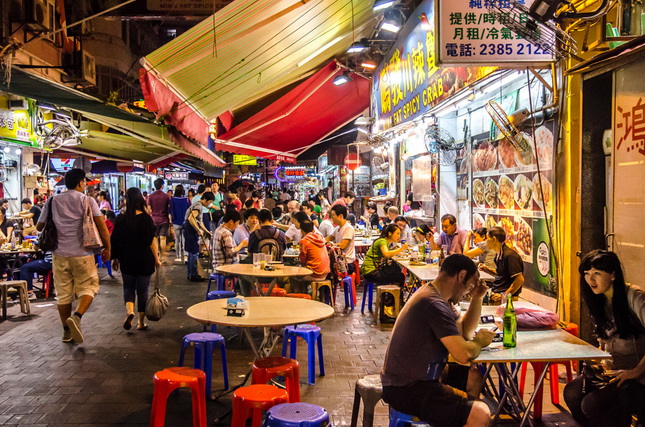Please enter the Verify Code |
Feature Story
The Dai Pai Dong Story
Hong Kong’s culinary legacy keeps the local flavour alive in a city of skyscrapers

The queue goes all the way down the street at two in the afternoon, with a few people pulling out umbrellas to shade themselves. The line ends at the intersection of Gough and Mei Lun Street, in a quiet neighbourhood just off Hong Kong Island’s Central district. What’s all this fuss about? What are these people queuing for? Many would be surprised to find out all that waiting is for a meal of instant noodles with beef in tomato broth.
Sing Heung Yuen is one of the most popular dai pai dongs or outdoor food stalls in Hong Kong. Having operated since the 1950s, the stall saw the heyday of the dai pai dong which lasted until the 1960s. In 1983, however, the government began to clamp down on licences due to sanitation issues. It was clear the dai pai dong needed to rework itself in order to survive.

Living, eating history
Literally “big plate stall” in English, the dai pai dong originated before World War II as a form of hawker store. Special licence plates were issued for “fixed-pitch” stalls (as opposed to itinerant hawkers) after the war, hence the name “restaurant with a big licence plate”.
The government stopped issuing new dai pai dong licences in the 1970s. A law was also enforced banning licenses from being transferred – since then dai pai dongs could only be continued by family members; otherwise, the business died with its vendor. Sadly, few children are interested in inheriting the business. Today, there are fewer than 28 establishments that can technically be classified as a dai pai dong; others, although similar in set up, are offshoots of the originals.
From the streets to the future
The essence of dai pai dong cuisine is the wok hei, or “breath of the wok.” This refers to the unique flavour achieved by stir frying food on a hot wok. The original stalls are said to have opened on the streets and piers of Central, but today the district of Sham Shui Po has the most dai pai dongs. is famous for having the greatest concentration of dai pai dongs in Hong Kong.
Dai pai dongs came into existence because people needed tasty, hearty food in a hurry. You could say it was Hong Kong’s first form of fast food, and some dai pai dongs are as good a place as any to enjoy authentic Cantonese and local Hong Kong food.
Despite the challenges of surviving in a constantly modernizing city (overregulation, new constructions taking over traditional spaces), the dai pai dong continues to thrive by reinventing itself. Many newer outlets have taken the the dai pai dong format and updated it: several have moved into government-run cooked food centres, usually found on top of public wet markets. Some have converted themselves into proper restaurants. Others have reimagined the dai pai dong into modern and hipper concept stalls. Regardless of its reinterpretation, though, one thing is clear: the dai pai dong is a symbol of Hong Kong’s character and is an icon that has inspired many.

3 Dai pai dongs to try
1. Sing Heung Yuen
Packed with diners, this dai pai dong feeds a mix of businessmen, tourists and workers. Its location on the artsy Gough Street is a plus, as well as its cleaner and airier ambience.
What to order: Instant Noodles with Ground Beef and Egg in Tomato Broth; Macaroni, egg, luncheon meat, and sausage in tomato soup; Pork Chop Bun; Honey Lemon Crispy Bun; Salty Lemon with Sprite.
2 Mei Lun Street, Central; 8:00 am-5.30pm
2. Ping Kee
So famous even celebrities drop in here for the milk tea, Ping Kee has been recognised by CNN as one of the four kings of milk tea in Hong Kong. With its traditional green-painted tin structure and street dining setup, you’ll get an authentic dai pai dong experience here.
What to order: Milk Tea with Condensed Milk; Pork Chop Instant Noodles with Spam/Egg
Next to 5 Shepherd Street, Tai Hang; 7.30am-4.30pm
3. Sing Kee
Hailed as Hong Kong’s best dai pai dong by various critics, Sing Kee is the iconic stall with fold-up tables on the street, faded red umbrellas for shade, and colourful plastic chairs right under the famous Mid-Levels Escalator in Central.
What to order: Stir-fried beef noodles, Sweet & Sour Ribs, Salt & Pepper Meat/Squid
9-10 Stanley St, Central; 11am-3pm & 5-11pm







